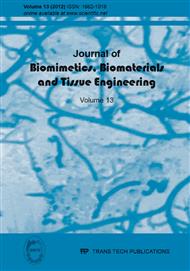[1]
J. Chung, K. Lee. Optimal design of rib structures using the topology optimization technique. Proceedings of the Institution of Mechanical Engineers, 211 C, 425-37, (1997).
DOI: 10.1243/0954406971521836
Google Scholar
[2]
D. Bojczuk and W. Szteleblak. Optimization of layout and shape of stiffeners in 2D structures. Computers and Structures; 86 (13-14), 1436-46, (2008).
DOI: 10.1016/j.compstruc.2007.05.005
Google Scholar
[3]
A. Kallassy, and J-L. Marcelin. Optimization of stiffened plates by genetic search. Struct Optim; 13 (2-3), 134-41, (1997).
DOI: 10.1007/bf01199232
Google Scholar
[4]
X. Ding, J. Lin, K. Yamazaki. Topology design optimization of stiffened thin-wall shell structures based on growth mechanism of root system. Chinese Journal of Mechanical Engineering; 4 (44), 201-5 (in Chinese), (2008).
DOI: 10.3901/jme.2008.04.201
Google Scholar
[5]
Y. X. Li, K. Xue. Mechanics in Leaf Venation Morphogenesis and their Biomimetic Inspiration to Construct a 2-Dimensional Reinforcement Layout Model. Journal of Biomimetics, Biomaterials, and Tissue Engineering; 10: 81-93, (2011).
DOI: 10.4028/www.scientific.net/jbbte.10.81
Google Scholar
[6]
C. Mattheck. Design in nature: Learning from trees. Berlin Heidelberg: Springer-Verlag, (1998).
Google Scholar
[7]
S. Bohn, B. Andreotti, S. Douady, J. Munzinger, Y. Couder. Constitutive property of the local organization of leaf venation networks. Phys Rev E 65, 061914-061925, (2002).
DOI: 10.1103/physreve.65.061914
Google Scholar
[8]
F. Corson, M. Adda-Bedia, A. Boudaoud. In silico leaf venation networks: growth and reorganization driven by mechanical forces. J. Theor. Biol. 259 (3), 440-8, (2009).
DOI: 10.1016/j.jtbi.2009.05.002
Google Scholar
[9]
A. Samanta, M. Mukhopadhyay. Finite element static analysis of stiffened shells. Appl. Mech. Engrg. 3(1), 55–87, (1998).
Google Scholar
[10]
A. Samanta, M. Mukhopadhyay. Free vibration analysis of stiffened shells by the finite element technique. European Journal of Mechanics A/Solids 23, 159-179, (2004).
DOI: 10.1016/j.euromechsol.2003.11.001
Google Scholar
[11]
S. Wang, L. Ren, Y. Liu, Z. Han, Y. Yang. Mechanical characteristics of typical plant leaves. J Bionic Eng.; 7 (3), 294-300, (2010).
DOI: 10.1016/s1672-6529(10)60253-3
Google Scholar
[12]
X. Ding, K. Yamazaki. Growth technique of stiffener layout pattern for plate and shell structures to achieve minimum compliance, Eng. Optimiz., 37 (3), 259-76, (2005).
DOI: 10.1080/0305215512331328231
Google Scholar
[13]
S. Zhang, J. Yang Jungang, W. Zhang. Evolutionary structural optimization for stiffener layout problem of plate structures. Modern Manufacturing Engineering; (4): 5-9, (2009).
Google Scholar


